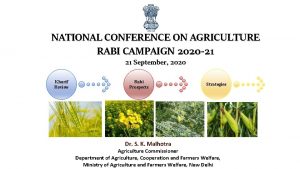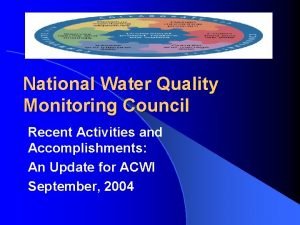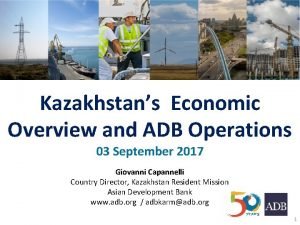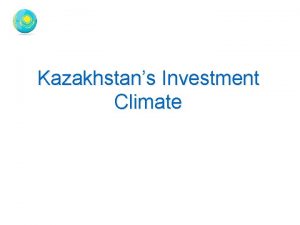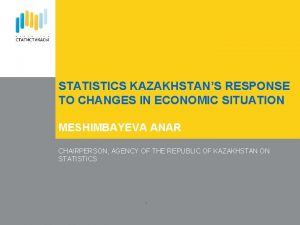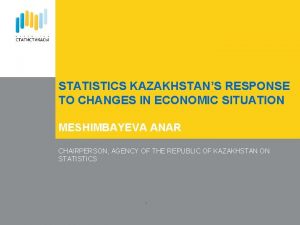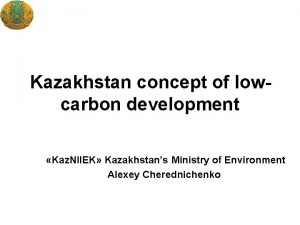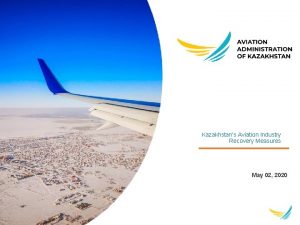Kazakhstans Second National Communication to the Conference of












- Slides: 12

Kazakhstan’s Second National Communication to the Conference of the Parties of the United Nations Framework Convention on Climate Change REPUBLIC OF KAZAKHSTAN Ministry of Environment Protection Valentina Kryukova Bonn, 2010 1

Climate change § Ubiquitous increase of seasonal and annual temperature § Increase of climate aridity in deserts and semi-deserts areas of Kazakhstan, as well as in adjacent areas. § Increase of total rainfall in the western and northern parts of Kazakhstan and in the central zone. The same trend was seen in the mountainous parts of the South and South-East of the country. However this had less impact on raising air temperatures. § Degradation of glaciers has been recorded by 0. 8% in South-East mountains and 1% in glacier storage. 2

Change of annual temperature and precipitation in Kazakhstan with change of GHG concentration according to different scenarios Temperature average P-50 +1, 4 С up to 2030; +2, 7 С to 2050; +4, 6 С to 2085 strict А 1 F 1 mild B 1 1, 2 1, 9 ºС (1, 3 ) 1, 5 2, 2 ºС (1, 7 ) 2, 5 4, 0 ºС (3, 0 ) 1, 6 2, 6 ºС (2, 0 ) 5, 7 to 8, 0 ºС (6, 2) 3, 1 3, 4 ºС (3, 3 Precipitation average P-50 2% to 2030, by 4% to 2050 by 5% to 2085 strict А 1 F 1 mild B 1 - 2 up to 8 % (2, 2 %) to 2030 0‑ 8 % (3, 0 %), - 4 to plus 15 % (3, 7 %) to 2050 minus 3 to plus 9 % (1, 7 %) 8 to 28 % (6, 5 %) to 2085 minus 2 to plus 13 % (4, 1%)

The assessment of humidity zones. 2071 -2100, А 1 F 1 4

Expected climate change: main conclusions § § Increase of seasonal and annual temperature Increase of precipitation in the winter period Increase of the annual sum of precipitation. Decrease of rainfalls in the summer period since 2050. § Precipitation does not compensate increase of air temperature § All scenarios of GHG concentration change tend to increase of aridity. 5

The potential impact of the climate change Water Resources § § will increase on the average from 1 – 4 % to 14 - 22% in mountain areas will decrease by 7 -10 % in the plain areas The degradation of the mountains glaciations and its impact on the resources of the river flow in the basin of the Lake Balkhash Agriculture a) Grain production § will be unfavorable for growing spring wheat in the northern part of Kazakhstan Yield productivity will decrease in the central, eastern parts by 25– 60 %, in the northern part by 70 – 90% versus the mean perennial values b) § § Pastures Change in structure, composition and decrease in biodiversity. Decrease in soil biomass by 30 -60 %. 6

§ § § Needs for adaptation measures To improve standards and legislation, to develop a strategy for reducing GHG emissions and increasing sinks. To streamline climate change issues into Sectoral Programs and Strategies. To improve the network of systematic observations, a forecasting system, modeling and early emergency information. To enhance research on climate change impact and its consequences to water resources, populations health and the economy. To increase awareness on climate change issues and measures needed for decision makers, business and public. 7

Total GHG emissions in Kazakhstan, Tg CO 2 -equivalent GHG Sources/sinks 1992 1994 1998 2000 2004 2005 Energy 280 261 128 138 185 197 Fuel combustion 246 236 113 119 164 176 Fugitive emissions 34 25 15 19 21 23 Industrial processes 15 7 7 11 14 15 Agriculture 46 34 16 17 21 23 LULUCF -7 -5 -5 -7 -6 -6 5 5 5 6 7 8 Total emissions 345 308 156 172 228 243 Net emissions 338 303 151 165 221 237 Waste 8

GHG emissions from «Energy: fuel combustion» by main sources, Gg CO 2 eqv. Energy Industry Transport Other sectors Other . 9

Dynamics of total CO 2 emissions under the various scenarios of economy development of RK The СО 2 emission scenarios were built using the MARKAL model. 10

The GHG emissions reduction potential from the main economy sectors by the strategic development and plans, effective technologies application, mln. t СО 2 Branches/scenarios Energy sector Base scenario The efficient growth of current and new power stations using effective technologies 2008 122, 8 119, 0 Years 2012 2016 139, 0 153, 1 126, 5 132, 8 2020 2024 162, 5 183, 1 131, 1 138, 3 Transport sector Base scenario Introduction of “Euro 2 - 4” standards 17, 1 22, 3 20, 7 29, 2 24, 5 36, 5 27, 4 44, 9 30, 1 Oil and gas sector Base scenario 23, 1 25, 6 29, 4 31 41 22, 4 24, 4 26, 7 28, 9 36, 0 188, 8 215, 2 242, 5 183 197, 6 211, 4 216, 1 234, 1 5, 83 17, 55 31, 57 47, 93 71, 98 Use of the effective, environmentally clean technologies The total GHG emissions in the base scenario The total GHG emissions using more effective technologies The total GHG emissions (potential) applying effective technologies and mitigation measures 264 306, 03 11

Thank you for your attention! 12
 27 miles per gallon into kilometers per liter
27 miles per gallon into kilometers per liter National youth at risk conference
National youth at risk conference Civil air patrol national conference
Civil air patrol national conference Aafp national conference
Aafp national conference Pbis national conference
Pbis national conference National conference on agriculture for summer campaign
National conference on agriculture for summer campaign Rtitom
Rtitom Cdha contact
Cdha contact National radiological emergency preparedness conference
National radiological emergency preparedness conference National conference for rabi campaign 2020
National conference for rabi campaign 2020 National business group on health conference 2018
National business group on health conference 2018 National 8a conference alaska
National 8a conference alaska National water quality monitoring council
National water quality monitoring council









